Hydrangea Sunday Fries - description, rules of care and methods of reproduction
The perennial hydrangea Sunday Fries belongs to the paniculate species. An ornamental flowering shrub was bred five years ago by the Frenchman Jean Reno. Today this plant is readily used in various compositions to decorate the garden. Consider what a flower looks like and what kind of care it needs.
- Plant characteristic
- Landing rules
- Site and soil selection
- Preparation of planting material
- Instructions
- Care features
- Watering
- Loosening and mulching
- Top dressing
- Pruning
- Preparing for winter
- Reproduction methods
- Seeds
- Cuttings
- By dividing the bush
- Stem layering
- Diseases and pests
- Application in landscape
- Testimonials
- Useful videos
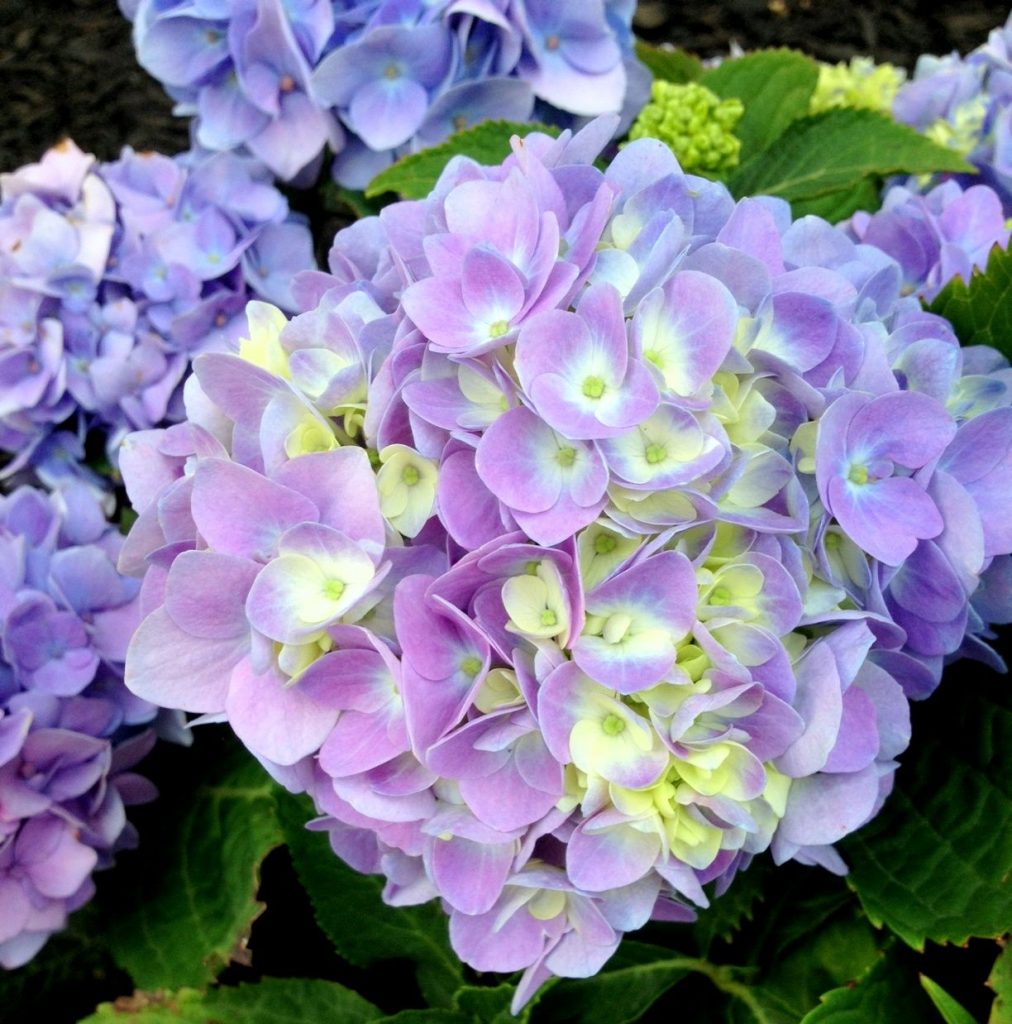
Hydrangea paniculata sandy fries
Plant characteristic
The Latin name is Hydrangea paniculata Sundae Fraise. Compact bushy plant up to 1.2 m high, with a circumference of 1 m.
Stems burgundy or dark purple, erect. Green leaves develop along the entire length of the shoots. The leaf plate is oval with a pointed tip with a smooth surface, size 8-9x3-4 cm.
Flowering begins in mid-June and lasts until the second half of October. One bush blooms beautiful buds of different shades - white, pink and bright crimson.
Small flowers with a circumference of 2-2.5 cm, collected in widely pyramidal inflorescences with a diameter of 28-30 cm.
The intensity of the color is influenced by the level of acidity of the soil.
The main advantages of a decorative perennial include an attractive appearance, the ability to develop on all types of soils, easily tolerates air pollution, therefore it can grow in any area.
Among the shortcomings, there is an increased need for moisture, heat, the need for insulation for the winter.
Landing rules
Growing this crop outdoors will be successful if you find a good planting site, optimal soil composition and high-quality planting material.
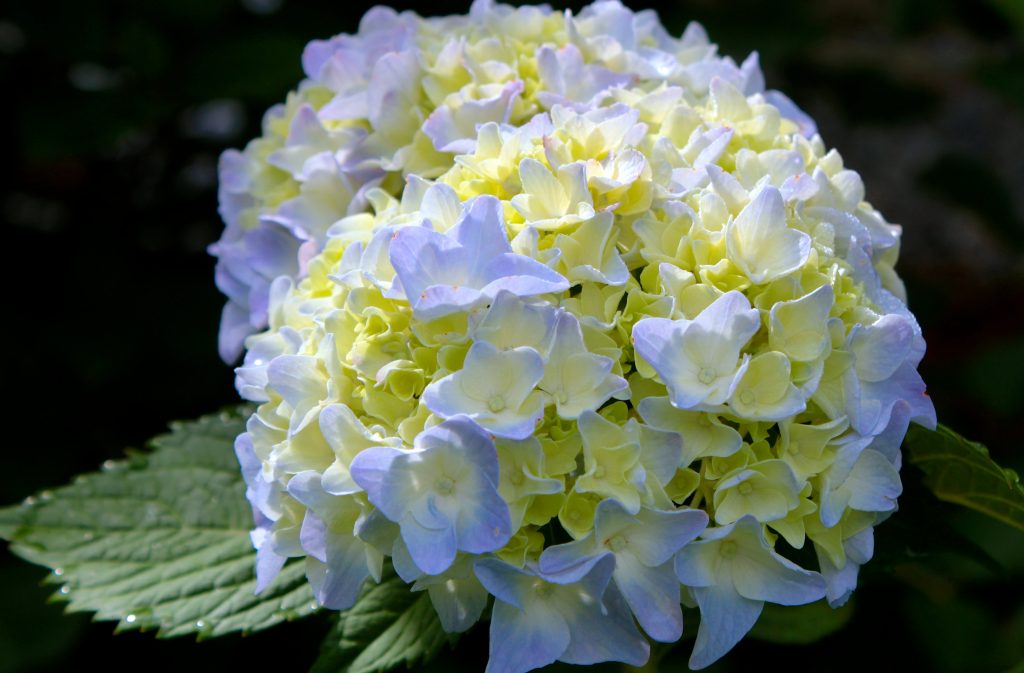
Panicle hydrangea sunday fries
Spring is considered the best time for planting seedlings - the period when the snow has thawed, but the vegetative buds have not yet begun to bloom. Can be planted in autumn, but no later than September 15, so that the seedlings have time to take root and prepare for the upcoming winter.
Site and soil selection
Despite the ability to grow on any type of soil, the plant will show its maximum decorative effect on light, loose soil with an increased content of mineral and organic fertilizers.
It grows well in a shaded area; in the sun, foliage and inflorescences quickly fade. You should not plant a shrub in a garden bed where there is a constant shadow - the stems will begin to stretch, the leaves will turn pale, and the flowering will not be so bright and prolonged.
Choose a place protected from the winds - this way you eliminate the risk of drying out the soil and roots. The optimum depth of groundwater is 2-2.5 m.
This plant prefers to grow in acidic soil, which contributes to a brighter and more lush flowering. To maintain this indicator at the desired level, potassium sulfate, ammonium sulfate or ferrous sulfate is added to the site before planting. The dosage is indicated on the package.
Preparation of planting material
For planting, you can use purchased seedlings from a horticultural nursery. When buying, carefully inspect the crown - there should be no signs of diseases and pests.
Choose plants that are 4-5 years old. These flowers have a well-developed root system, and the crown consists of several shoots. The underground part should be with an earthen lump or planted in a container. Bushes with an open root dry out quickly, and after landing on the site, they may not take root.
Before planting, the plant is watered abundantly, after an hour it is removed from the container, the roots are examined. All questionable parts are cut with a sterile pruning shears, then irrigated with a solution of copper sulfate.
If you have acquired seedlings with open roots, then before planting, the root system is soaked in Kornevin or Zircon for 60 minutes. This treatment stimulates rapid and successful rooting.
Instructions
Before planting, the site is freed from garden debris, dug up, leveled. Pull holes a little larger than the size of an earthen coma. Approximate parameters - 30-40x50-70 cm.
First, a layer of drainage is laid from pebbles, crushed stone, screenings and brick chips. Then they are half filled with the nutrient composition from the dug earth and humus (compost) - in a bucket. Add to this mixture 300 g of wood ash, 50 g each of superphosphate and potassium sulfate.
A lump with roots is lowered, straightened, all voids are sprinkled with soil, trampled around the stems, watered. Consumption per plant - 10 liters of water.
When planting a seedling, it is important that the root collar remains 4-5 cm above the soil surface. For group cultivation, the scheme is observed - 1.2x1 m.
All bushes must be mulched with a thick layer of coniferous sawdust, peat or compost. Mulch protects the soil from drying out and prevents the growth of unnecessary vegetation in the flower garden.
Care features
Hydrangea paniculata sundae fraise does not require much attention. She needs to be provided with regular hydration, nutrition and periodic pruning.
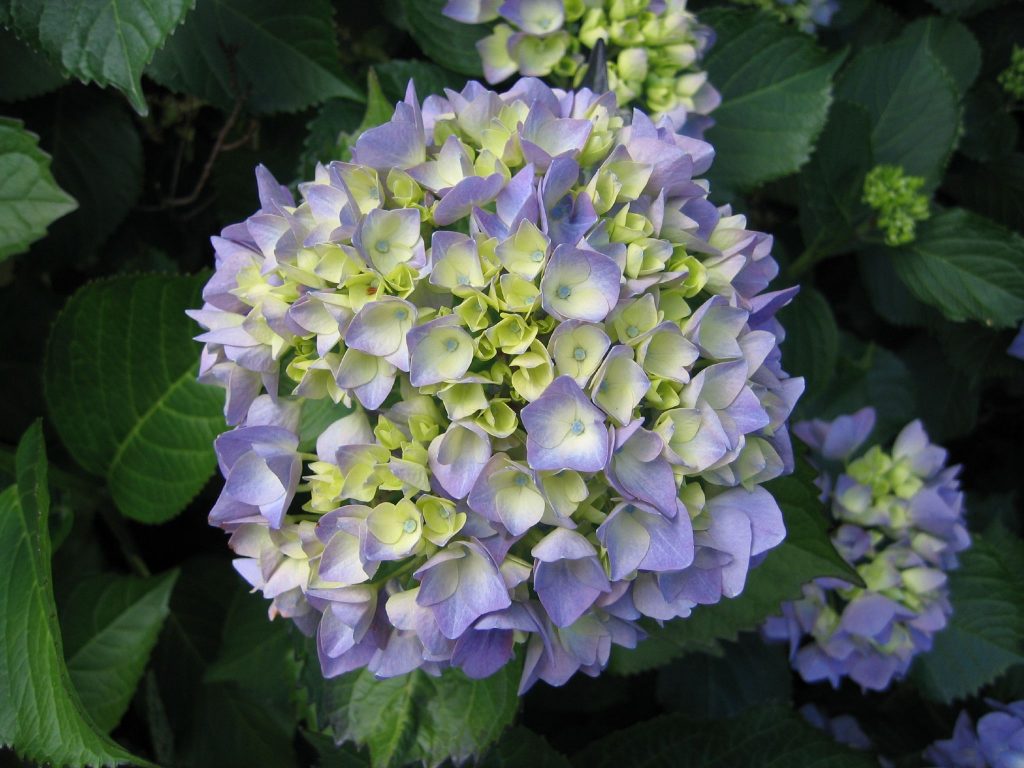
Sunday fries hydrangea photo
Watering
He loves moderate humidity, so you need to constantly monitor the condition of the soil so that it is slightly moist. For irrigation, take settled water at room temperature. To maintain acidity at the required level, when moistened, add apple cider vinegar or citric acid to the water - 10 g per bucket of water. 5 liters of solution are poured under one plant.
In spring and summer, water as needed - if the soil has dried out to a depth of 5-6 cm, it's time to moisten. Closer to autumn, the frequency is reduced to once every two weeks. Water stops pouring 20 days before the onset of the first frost.
Loosening and mulching
After watering, the near-stem zone is loosened to maintain its aeration. Additionally, the soil is weeded between the rows, weeds are removed.
Be sure to add a layer of peat or humus mulch so that the moisture does not evaporate quickly.
Top dressing
Hydrangea Sunday Fries should be fed regularly. The nutrients will provide good immunity against diseases, a high degree of frost resistance and decorative effect.
Mineral components and organic matter are introduced in turn. They use ready-made preparations for decorative flowering shrubs. The frequency of application throughout the growing season is once every three weeks. After each meal, abundant watering is carried out to improve the absorption of nutrients.
Pruning
This plant can be given a beautiful and compact standard shape. Cut immediately after planting - choose a strong stem, the remaining branches are completely cut into a ring. The central branch is shortened by 10-15 cm annually until it reaches 1 m in height. In subsequent years, the trunk is pinched, shoots are additionally cut out, which develop along the entire length of the trunk.
For good branching, 4-5 of the most flexible stems are left, the rest are cut off. This manipulation is done every year to make the crown compact and symmetrical.
In parallel, in early spring, branches that are frozen, broken off, dried out or damaged by diseases are removed.
Older hydrangeas need a rejuvenating haircut to stimulate young growth and improve flowering quality. The branches are cut off from the age of five years, leaving only a few young shoots. They are shortened by a third of the length.
All procedures are performed with a sharp and sterile instrument. To avoid infection, the bush after cutting is irrigated with a solution of copper sulfate.
Preparing for winter
Despite its good winter hardiness, this culture will need insulation in the first years of growing in open ground.
The twigs are tied with twine, bent to the ground, and fixed with staples. From above, the crown is covered with fallen leaves or covered with spruce branches. Then covered with sheets of slate or film.
All insulation procedures are carried out in the fall, a couple of weeks before the upcoming cold weather.
Reproduction methods
There are several ways to propagate a perennial shrub, each with advantages and disadvantages.
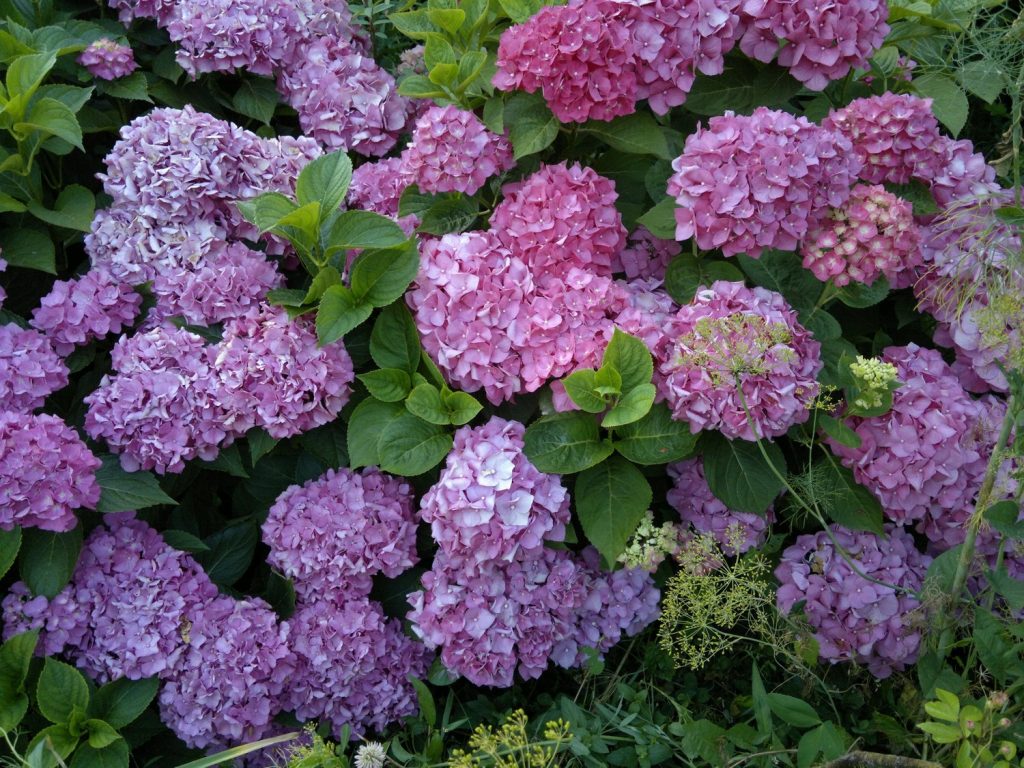
Hydrangea sunday fries photo
Seeds
This is a time consuming process that will take a lot of time and patience from you, but if you do it right, you can get a lot of new seedlings. The disadvantage of this method is that it is almost impossible to grow varietal seedlings from the seeds of the mother bush.
Sowing seeds is carried out in the spring - at the end of March or at the beginning of April. Take seedling boxes or plastic containers, fill it with a nutrient substrate (humus, leafy earth, sand and peat - 2: 2: 1: 1). Sow, then sprinkle with a thin layer of sand, irrigate from a spray bottle.
At a temperature of 20-25 ° C, diffused light and regular moisture, sprouts will appear in a month. For full development, the bushes are fed with liquid mineral fertilizers every two weeks.
As they grow, the seedlings are thinned out, yellowed specimens are removed. By autumn, seedlings will reach 30-40 cm in height. In the first half of September, they are seated separately in a flower garden.
Cuttings
The best time for such breeding is early or mid-July. Cut the most flexible and strong shoots of the current year, adjacent to the main branch. It is important that they do not break when bent. Each branch 15-20 cm long should have 2-3 leaves and several live buds.
Cuttings are planted in a wet mixture of peat and sand - 2: 1. To increase the moisture content of the substrate, add 0.5 parts of crushed moss to it. For fast rooting, the planting material is dipped in Kornevin's solution. The embedment depth is 3-4 cm, the angle of inclination is 40-45 ° С.
At a temperature of 18-22 ° and diffused daylight, the seedlings will release roots in 2-3 weeks. As soon as 2-3 pairs of new leaves appear on them, they should be planted separately in the flower garden.
By dividing the bush
This method of reproduction is advisable to use when you need to rejuvenate an old bush from the age of 8 years. The procedure is started in spring or early autumn.
The bush is watered abundantly, after an hour it is dug in, removed, and the root system is washed from the ground. After drying, they are divided with a shovel into several parts, so that each has 2-3 roots, one shoot with buds and leaves.
To avoid infection, the cut off places are irrigated with a solution of copper sulfate, dried, sprinkled with chopped charcoal. They are planted according to the same scheme and rules as purchased seedlings.
Stem layering
Some people manage to successfully grow new bushes using stem cuttings. In early autumn, a flexible last year's branch is chosen on an adult plant. Remove all the leaves on it.
Next to the bush, a trench is dug 4-5 cm deep, a little mixture of sand and peat is poured into it. The branch is lowered in a horizontal position, fixed with staples, sprinkled with the remaining substrate, moistened.
Closer to the first frost, sprinkle with garden soil, fallen leaves or coniferous sawdust to protect the branch from freezing in winter.
In the spring, as soon as the snow thaws, the positive outside temperature stabilizes, and the escape is dug up. They are cut off from the mother bush, divided into several parts so that each has roots, planted separately.
Diseases and pests
Hydrangea Sunday Fraise is damaged by the same infections and parasites as other representatives of the paniculate species:
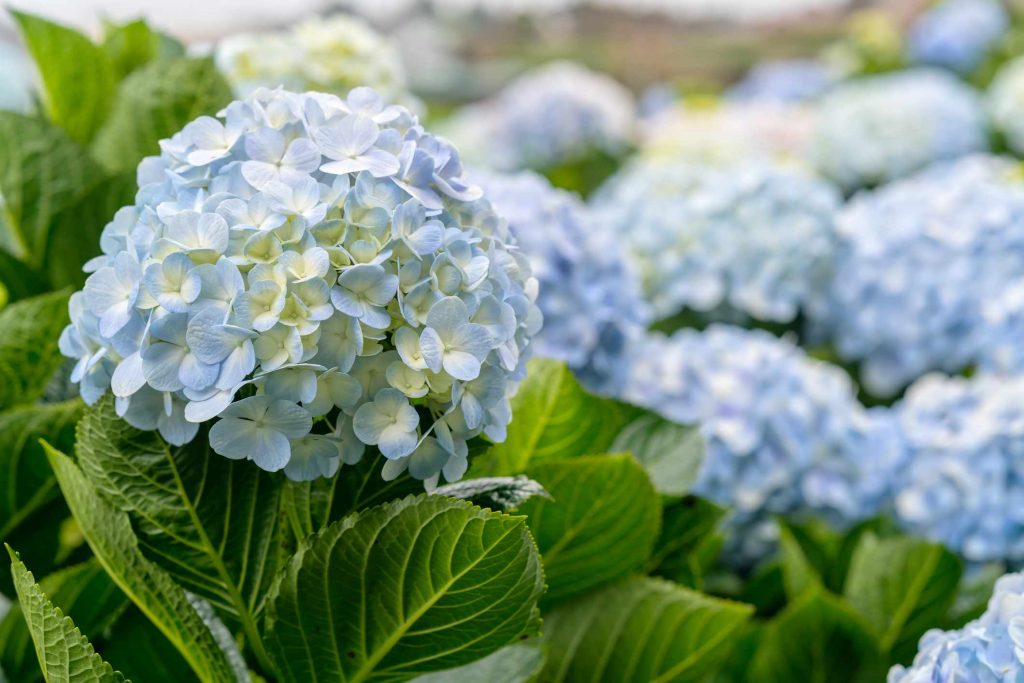
Hydrangea sundae fraise
- Downy mildew. Signs of infection are oily spots on the foliage surface. For treatment and preventive treatments in early spring and late autumn, several drugs are used - Quadris, Boxwood, a solution of copper sulfate.
- Gray rot. You can identify this sore by the brown specks on the leaves. To fight infection, use the same means as for downy mildew.
- Chlorosis. The leaves turn pale, yellowish streaks can be traced on their surface. The development of this sore is characteristic of hydrangeas growing in alkaline earth. To improve the composition, the crown and soil are irrigated with iron chelate or potassium nitrate.
- Ring spot. It is not difficult to determine it - the outer side of the leaves is covered with ring spots. There are no drugs for the treatment of this disease, so the infected hydrangea is disposed of, and the place of growth is spilled with a strong solution of potassium permanganate or copper sulfate.
- Spider mites, leaf rollers, aphids. All these are sucking insects that love to feast on the juice of foliage, buds, young shoots. At the initial stage of infection, home remedies are used - they irrigate the crown and the soil under it with an ash and soap solution, infusion of garlic, onions or hot pepper. The neglected shrubs are treated with chemistry - Aktara, Aktellik, Fitoverm or Iskra.
To protect this plant from various sores and pests, it is necessary to buy healthy seedlings, follow the planting scheme, fertilization rules, regularly cut off diseased parts and remove infected organs in time.
Application in landscape
The Sunday Frize panicle hydrangea is of great value in modern floriculture:
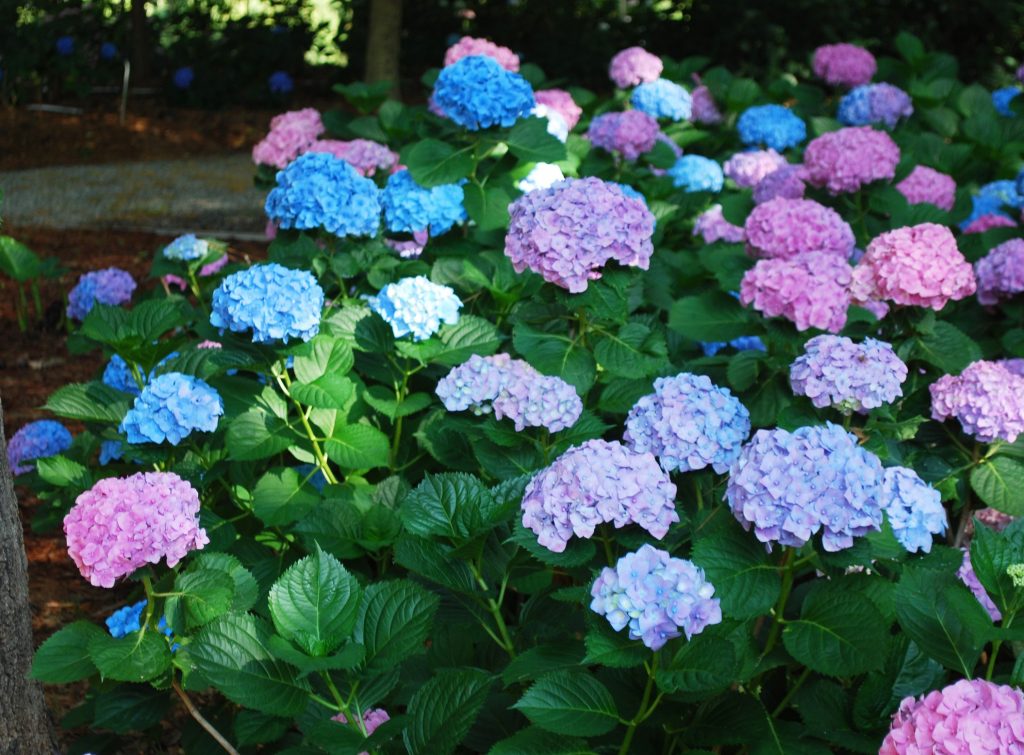
Sundae fraise hydrangea
- it is planted singly in the center of flower beds, near gazebos, terraces;
- combined with other varieties, as well as decorative perennials - roses, junipers, fir, hosta;
- a few shrubs planted along the fence look beautiful - they create a bright and lush hedge.
Testimonials
Thanks to its ability to fully develop and bloom on all types of soils, the sundae fraise variety has won the hearts of many growers:
- has good winter hardiness, can grow in partial shade, therefore it is suitable for decorating any, even the northern corner of the garden;
- when properly formed, it does not take up much space, it looks compact and attractive;
- by changing the acidity of the soil, you can achieve more saturated and multi-colored shades of inflorescences.

